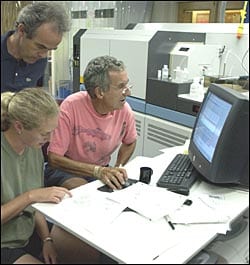News Releases
Scientists Map Ocean Floor Near Palmer Station in Antarctica
Using inflatable boats, a portable depth sounder with GPS, and a REMUS autonomous underwater vehicle, a team of scientists and engineers has created the first detailed, comprehensive chart of the […]
Read MoreHurricanes and the Coastal Zone
With hurricane season arriving June 1, along with predictions of an above normal number of major storms in the Atlantic and Gulf States, understanding how the ocean and atmospheric interact […]
Read MoreWhat is That in the Water?
As summer vacations approach, beachgoers might want to bring along a guide to what they and their children will see on the beach and in the water. WHOI scientists and […]
Read MoreBlooms of a Different Sort
Commonly called “red tides,” harmful algal blooms, or HABs, are an abundance or “bloom” of single-celled marine algae called phytoplankton that grow and multiply under the right conditions. Among the […]
Read MoreG. Unger Vetlesen Foundation Honored by Woods Hole Oceanographic Institution
Woods Hole Oceanographic Institution recently honored The G. Unger Vetlesen Foundation of New York with the prestigious Cecil H. Green Award. The award, named for Texas Instruments’ founder and philanthropist […]
Read MoreWHOI Scientists Monitor Largest Red Tide Outbreak in 12 Years in Massachusetts Bay
With shellfish beds from Maine to the Cape Cod coast closed from the largest outbreak of red tide in 12 years in Massachusetts Bay, scientists from the Woods Hole Oceanographic […]
Read MoreNew Underwater Volcano Found Near Samoa
An international team of scientists, led by researchers at the Woods Hole Oceanographic Institution, Scripps Institution of Oceanography, University of Oregon and University of Sydney, has discovered an active underwater […]
Read MoreScientists Find Unusual Use of Metals in the Ocean
Cadmium, commonly considered a toxic metal and often used in combination with nickel in batteries, has been found to have a biological use as a nutrient in the ocean, the […]
Read MoreWHOI Scientist Elected to American Academy of Arts and Sciences
Woods Hole Oceanographic Institution (WHOI) Senior Scientist Stanley Hart of the Geology and Geophysics Department was recently elected a Fellow of the American Academy of Arts and Sciences, one of […]
Read MoreDiving to the Rosebud Vents – Galápagos Rift
In 2002, researchers diving in the submersible Alvin returned to the Galápagos Rift, a mid-ocean ridge about 250 miles from the Galápagos Islands in the eastern Pacific Ocean where hydrothermal […]
Read MoreTiny Computer Tag Provides Insight to Reclusive Beaked Whales
A miniature computer weighing less than 5 ounces attached to the backs of beaked whales with suction cups is providing new clues to the behavior and sounds made by the […]
Read MoreExploring the Seas from Top to Bottom
WHOI research vessels are exploring the oceans this spring from Bermuda to the Bay of Fundy in the North Atlantic and from Mexico to the Galápagos Islands in the eastern […]
Read MoreSalty Staircase in the Atlantic Provides Clues to Ocean Mixing
Layers of salty ocean water mix with layers of fresher water, creating a salty staircase or layering driven by small-scale convection known as salt fingers. Although scientists have known about […]
Read MoreSea Squirt Invasion: Scientists Gather at WHOI for First International Conference
Scientists, natural resource managers and students from four continents will gather at the Woods Hole Oceanographic Institution (WHOI) April 21 and 22 to discuss a growing global problem: the sea […]
Read MoreNew Coral Dating Technique Helps Resolve Changes in Sea Level Rise in the Past
Corals from Papua New Guinea and Barbados indicate that changes in sea level, one of the key indexes for global climate change, may have been more frequent in the past […]
Read MoreWHOI Establishes Award to Recognize Contributions of Navy Admiral, Oceanographer
A former Oceanographer of the Navy and Rear Admiral who headed Marine Operations at the Woods Hole Oceanographic Institution (WHOI) for 14 years has been honored by the Institution with […]
Read MoreChanges in Earth’s Tilt Control When Glacial Cycles End
Scientists have long debated what causes glacial/interglacial cycles, which have occurred most recently at intervals of about 100,000 years. A new study reported in the March 24 issue of Nature […]
Read MoreElephants Imitate Sounds as a Form of Social Communication
Elephants learn to imitate sounds that are not typical of their species, the first known example after humans of vocal learning in a non-primate terrestrial mammal.
Read MoreUnderwater Robot Launched from Bermuda to Cross Gulf Stream
A small autonomous underwater vehicle, or AUV, named Spray was launched yesterday about 12 miles southeast of Bermuda. The two-meter-(6-foot)-long orange glider with a four-foot wingspan will slowly make its […]
Read MoreDeep-Sea Tremors May Provide Early Warning System for Larger Earthquakes
Predicting when large earthquakes might occur may be a step closer to reality, thanks to a new study of undersea earthquakes in the eastern Pacific Ocean. The study, reported in today??A’s Nature, is the first to suggest that small seismic shocks or foreshocks preceding a major earthquake can be used in some cases to predict the main tremors.
Read MoreAssessing Algerian Earthquake Risk
Scientists from WHOI and USGS Menlo Park will be assessing future earthquake risk in Algeria and training Algerian researchers under a new two-year project funded by the Office of Foreign […]
Read MoreScanning the Seafloor
WHOI researchers and colleagues from other laboratories will be able to look at mud from the seafloor in a new way, thanks to a high-tech scanner capable of making rapid, […]
Read MoreBarnacles and Mangroves
In a lush stand of mangroves on the Pacific coast of Panama, a Woods Hole Oceanographic Institution (WHOI) biologist is looking for encrusting barnacles and oysters, common on the roots […]
Read MoreDuke, Woods Hole Geologists Discover ‘Clockwork’ Motion by Ocean Floor Microplates
CONTACTS
Monte Basgall
(919) 681-8057
Shelley Dawicki
(508) 289-2270
DURHAM, N.C. — A team of geologists from Duke University and Woods Hole Oceanographic […]
Read More
